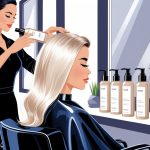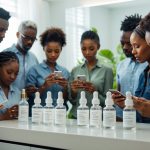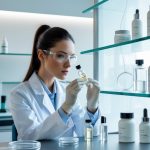Facial Serum Claims Now Under Scrutiny as Dermatologists Warn Busy Shoppers
Reading Ingredient Labels Like a Pro
Ingredient lists—ugh, why do I keep staring at them like they’ll reveal some hidden truth? The front of the bottle is a joke; it’s all stickers and empty promises. I’ve literally picked up “clean” serums with alcohol denat and witch hazel right at the top. No wonder my face felt like it was melting that one time after exfoliating. Ignore whatever the bottle brags about. Flip it over. Scan for stuff like niacinamide, retinol, squalane (hydration that actually lasts), and ascorbic acid—if they’re listed near the top, you might be getting more than a whiff.
A dermatologist once muttered at a conference, “Retinol in the morning? Enjoy your sunburn.” I wrote that down, possibly in the wrong app, but whatever. The FDA says anything over 1% has to go in order, so if “Super Botanical X™” is last, it’s basically fairy dust. And maybe don’t trust a serum that smells like a perfume counter exploded. If your patch test leaves your face looking like you just ran a marathon, just nope out of there. Your skin doesn’t care what some influencer calls their “holy grail.”
Making Sense of Product Transparency
Every time I wander into the drugstore, it’s chaos—“clean beauty” everywhere, “clinically proven” nonsense, ingredient lists that might as well be written in ancient runes. I swear, dermatologists keep saying transparency means something different every year. One brand dumps the whole INCI list, another just says “no parabens” like that’s the gold standard. Nobody agrees. Meanwhile, I’ve got half-used serums collecting dust because I got sucked in by the claims.
The Role of Regulations and the FDA
I’ve read the FDA site (don’t bother, it’s a wall of noise). They don’t “approve” cosmetics, just kind of…exist? But if a brand lies, they’re technically liable. Not that anyone’s checking. Some regulatory manager at Cosmed told me “clean beauty” is basically a made-up term. So brands toss out “dermatologist tested” or “hypoallergenic” with zero actual proof. I’ve seen brands shuffle actives to the bottom of the list just to look good. The FDA? They only show up if something blows up on social or people start breaking out in hives—otherwise, it’s a free-for-all.
Evaluating Brand Claims and Ingredient Lists
Oh, and “organic botanicals”—don’t get me started. What does “organic” mean if there’s no global standard and nobody’s checking the farms? Deciem, Drunk Elephant, all those “transparent” brands—reading their ingredient lists still gives me a headache. NPD Group says nearly half of women want organic ingredients, but does anyone know what “ethylhexylglycerin” actually is? Me neither. “Clinically tested” usually means they got 15 people to try it and called it a day. My only trick: ignore the front, flip the bottle, Google the weird Latin words, and hope for the best. Or just text your derm, who will probably say, “Just wear SPF and chill.”
Tips for Achieving Healthy, Glowing Skin
I’ve wasted years (and way too much money) on “miracle” serums, sketchy oils, and TikTok “overnight glow” hacks. It’s all noise. The real deal? Boring routines, actual sunscreen (not that tinted moisturizer stuff), and not nuking your face with a chemical soup every night.
Building a Simple, Effective Skincare Routine
Twelve-step routines? Been there, regretted that. My dermatologist (real credentials, not Instagram) just laughed when I showed her my bathroom shelf. She pointed at my sad, grainy scrub and said, “Your face hates drama.”
So, I keep it basic: gentle cleanser, twice a day. Moisturizer with ceramides or hyaluronic acid—no unicorn tears, thanks. If I’m in the mood, niacinamide serum, because apparently it does something for redness. But honestly, less chaos = happier skin. If you want more elastin, stop torching your moisture barrier.
Tried a viral 14-step routine once. My skin revolted. Couldn’t smile for a week. Simplicity wins. If it stings or smells like Windex, toss it.
Protecting Your Skin with Sunscreen
Best advice I ever got? SPF 30, every single day, even if you’re just checking the mail. Sounds extreme, but the stat was something like 24% less aging if you use it daily. Did it help my college photos? Doubtful.
I used to think BB cream SPF was enough—nope. Physical sunscreens (zinc oxide) make me look like a ghost, but at least they work. Chemical ones absorb faster but sometimes burn my eyes. Pick what doesn’t break you out. SPF 100 is pointless—nobody reapplies that much. Sunscreen keeps your skin from looking like a tomato and, I guess, helps with “glow.”
But, yeah, sunscreen sticks melt in hot cars and glue themselves to your keys. Why does no one mention that?
Avoiding Overuse and Skin Irritation
Every time I see a “glass skin” transformation, I want to pile on more acids. Bad idea. My cheeks get red and flaky, and then I remember Dr. Jhin (she’s everywhere) saying, “Over-exfoliation is the real problem.”
Most “radiance” serums just speed up cell turnover—translation: thin your skin if you’re not careful. Less is safer. If you want to keep your face happy, stop trying to outsmart your barrier.
Scrub + peel in one night? I did that. Didn’t touch anything but bland moisturizer for days. Irony: my skin looked better after doing nothing. Now it’s cleanser, moisturizer, sunscreen, and maybe a prayer that my cat doesn’t knock it all over.



